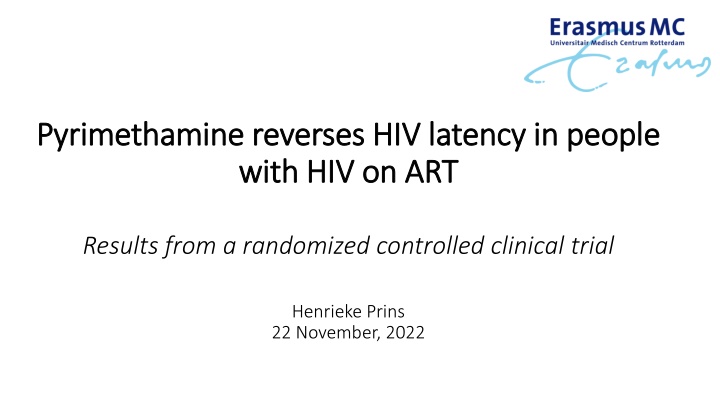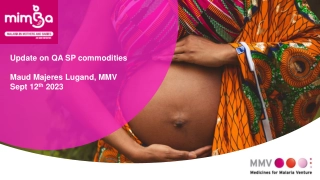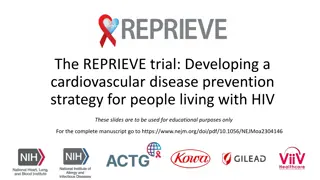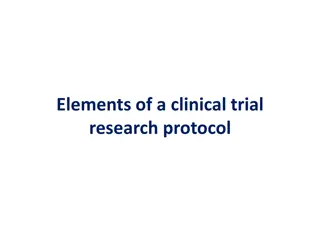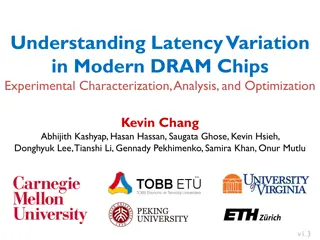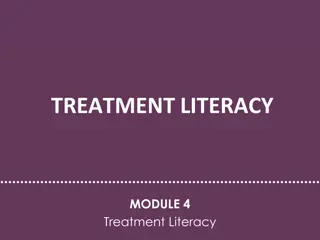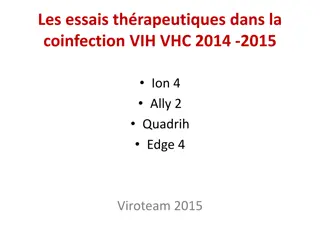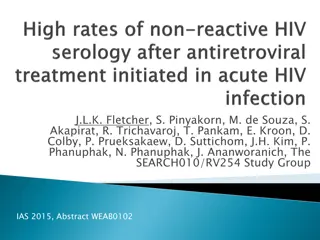Pyrimethamine Reverses HIV Latency: Clinical Trial Results
Pyrimethamine has shown promise in reversing HIV latency in people on ART, potentially impacting HIV cure strategies. Explore the findings from a recent clinical trial in this field.
Uploaded on Feb 15, 2025 | 1 Views
Download Presentation

Please find below an Image/Link to download the presentation.
The content on the website is provided AS IS for your information and personal use only. It may not be sold, licensed, or shared on other websites without obtaining consent from the author.If you encounter any issues during the download, it is possible that the publisher has removed the file from their server.
You are allowed to download the files provided on this website for personal or commercial use, subject to the condition that they are used lawfully. All files are the property of their respective owners.
The content on the website is provided AS IS for your information and personal use only. It may not be sold, licensed, or shared on other websites without obtaining consent from the author.
E N D
Presentation Transcript
Pyrimethamine Pyrimethamine reverses reverses HIV with with HIV on ART HIV on ART HIV latency latency in in people people Results from a randomized controlled clinical trial Henrieke Prins 22 November, 2022
Disclosure of speakers interests (Potential) conflict of interest None Relations that could be relevant for the meeting None
Background: why no cure? Replication-competent latent HIV reservoir can spark viral rebound when ART is stopped
Background: cure strategies Stoszko et al. Current Opinion in Virology 2019 Latency reversing agents (LRAs) can reactivate the latent HIV reservoir
Background: role of BAFi and HDACi The BAF complex is a key repressor of HIV transcription BAF complex inhibitors (BAFis) can act as LRAs BAFis enhance the effect of other LRAs ex-vivo (i.e. histone deacetylase inhibitors) Stoszko et al. Current Opinion in Virology 2019
L LRAs RA s U United as nited as N Novel ovel A Anti nti- -HIV strategy HIV strategy Investigate the impact of pyrimethamine (BAFi) and valproic acid (HDACi) on the HIV reservoir Primary endpoint: in HIV reactivation measured as in cell associated (CA) HIV-RNA after start of treatment Secondary endpoints: in reservoir size (Tat/rev Induced Limiting Dilution Assay (TILDA)) after start of treatment Clinical safety and tolerability of the administered compounds
Changes in CA HIV-RNA per arm at four time points during the LUNA study Pyrimethamine: rapid and sustained increase in CA HIV-RNA in CD4+T-cells Valproic acid: no increase in CA HIV-RNA, no synergistic effect
Gene expression profile of BAF complex molecular targets BAF target gene expression corresponded to pyrimethamine-induced HIV reservoir reactivation
Median total plasma levels in study arms involving pyrimethamine Pyrimethamine plasma levels corresponded to pyrimethamine-induced HIV reservoir reactivation No reduction in inducible reservoir size as determined by TILDA (data not shown) No serious adverse events, but physician-directed treatment adjustments occurred
Conclusion Pharmacovigilance in HIV cure trials involving combinatorial (LRA) strategies is important Pyrimethamine reverses HIV latency in vivo, supporting its advancement in clinical studies Valproic acid is not a clinically useful LRA in HIV cure research The optimal partner drug for pyrimethamine is to be determined
Acknowledgement Jeroen IJpelaar All participants of the LUNA trial Biochemistry Dorine de Vries Janet de Wilde TokamehMahmoudi Els van Nood All member of the Erasmus MC HIV Eradication Group (https://eheg.nl) Shringar Rao Jan Nouwen Pharmacy Raquel Crespo Karin Schurink Birgit Koch Robert-Jan Palstra Rene van Engen All lab technicians, phlebotomists, hiv nurse practitioners, outpatient staff members Letao Li Tonmoy Hossein Viroscience Immunology Infectious diseases David van de Vijver Peter Katsikis Annelies Verbon Charles Boucher Erasmus MC Mrace (2016) Yvonne Muller Casper Rokx Rob Gruters Albert Groenendijk Thibault Mesplede Pharmacy Radboudumc Biostatiscis Mariana de Mendonca Melo Jeroen van Kampen Angela Colbers Grigorios Papageorgiou Hannelore Bax Cynthia Lungu David Burger Bart Rijnders Ronald Overmars Eric van Gorp Georgina Arron
Baseline Characteristics Overall PYR VPA PYR+VPA Control n =28 28 (100) N=7 7 (100) N=7 7 (100) N=7 7 (100) N=7 7 (100) Male Ethnic origin -White European -Latin American or Hispanic -Black Caribbean Age (years) HIV subtype Ba History of AIDS Years from HIV diagnosis until inclusion Years on cART Years with HIV-RNA <50 copies per mL Initiated cART during acute HIV infection Pre-cART plasma viral load zenith log10 copies per mL Pre-cART nadir CD4+ T-cell count per L CD4+ T-cell count per L at inclusion cART -NNRTI basedb -INSTI basedc 24 (86) 3 (11) 1 (4) 54 (47-61) 24 (85.7) 8 (29) 8.5 (7.5-15.4) 7.5 (5.6-11.7) 6.8 (4.9-11.1) 3 (11) 4.9 (4.7-5.3) 4 (43) 3 (57) 0 53 (48-55) 7 (100) 2 (29) 7.7 (7.5-14.5) 7.3 (6.4-12.0) 6.7 (5.1-11.5) 2 (29) 5.3 (4.9-5.6) 7 (100) 0 0 51 (54-67) 6 (86) 1 (14) 7.8 (7.6-12.8) 7.6 (6.1-10.8) 7.2 (5.4-9.5) 1 (14) 4.8 (4.6-5.0) 6 (86) 0 1 (14) 51 (45-58) 6 (86) 3 (43) 7.6 (5.2-9.4) 5.6 (4.7-7.4) 5.1 (4.5-7.1) 0 4.9 (4.8-5.0) 7 (100) 0 0 55 (51-64) 5 (71) 2 (29) 15.6 (10.5-20.2) 9.8 (8.0-13.0) 7.2 (5.2-12.5) 0 4.9 (4.7-5.4) 235 (160-315) 665 (530-820) 290 (135-310) 610 (490-770) 250 (225-295) 750 (560-810) 240 (175-420) 630 (475-1005) 210 (170-225) 680 (590-740) 16 (57) 12 (43) 5 (71) 2 (29) 4 (57) 3 (43) 4 (57) 3 (43) 3 (43) 4 (57)
No SAEs and no SUSARs Total number of self-reported AE adverse events and their severity during trial participation per study arm Arm 1: VPA Arm 2: PYR Arm 3: VPA+PYR Arm 4: control There were no >3 grade adverse events. VPA: valproic acid; PYR: pyrimethamine. Table 3. Total number of self-reported adverse events and their severity during trial participation per study arm All study-related AEs resolved (n = 91) Most commonly reported AEs included nausea (n = 12), vomiting (n = 12), vertigo (n = 6), and headache (n = 6) Grade 1 13 33 32 4 Grade 2 2 3 13 0 Grade 3 0 2 1 0 Any grade 15 38 46 4 Three grade 3 AEs (syncope): two related to blood draw 1
